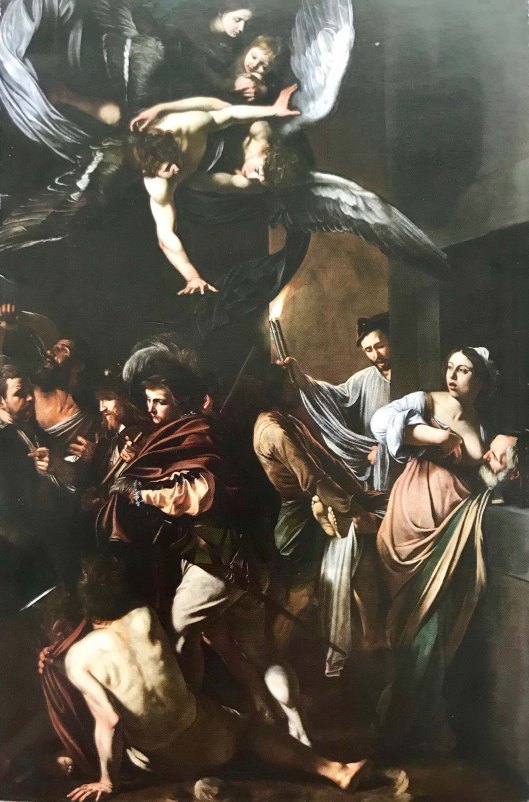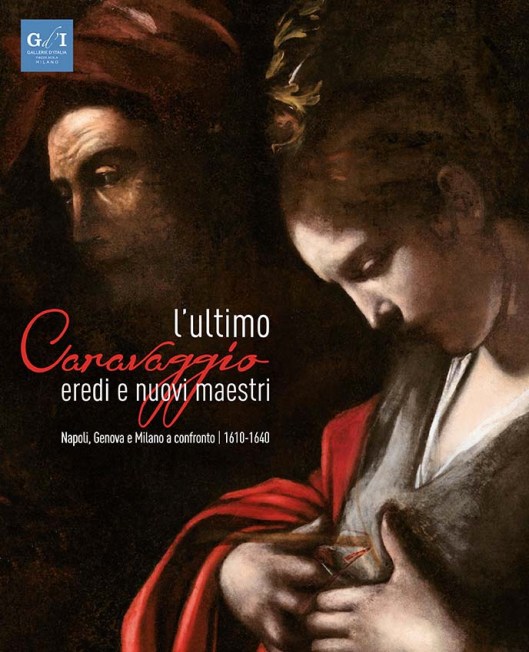Tags
Baroque art, Caravaggio, Life of Caravaggio, Napoli, Palazzo Zevallos Stigliano, Pio Monte della Misericordia, Roma, Sant'Orsola
 410 years ago today, Caravaggio died in a tavern in Porto Ercole. This is about his last painting and the time I went to see the WRONG Caravaggio. I rarely use the words wrong and Caravaggio in the same sentence, but in this case it works.
410 years ago today, Caravaggio died in a tavern in Porto Ercole. This is about his last painting and the time I went to see the WRONG Caravaggio. I rarely use the words wrong and Caravaggio in the same sentence, but in this case it works.
A few years ago, I had an extremely Caravaggio’d out day in Roma. After my visit to Galleria Borghese, I stopped in to see more Caravaggio works at Santa Maria del Popolo, then met a friend at Sant’Agostino to see the Madonna dei Pellegrini. Whew! I ended up in a Caravaggio Coma and had the best day ever!
When my friend Romano heard I was going to Sant’Agostino, he immediately offered to meet me there. I remember thinking this was odd, since I knew he had a full day. As soon as we approached the painting, and he said ‘Questo è il collo più sensuale nella storia dell’arte /This is the most sensuous neck in the history of art’, I realized he was a fellow Caravaggio nerd. This was, in fact his favourite painting. Afterwards, we went to have caffè freddo and talked about Caravaggio for an hour!
Romano had recently been to Napoli and told me about a Caravaggio painting in a former church owned by a bank. The bank bought the building and it came with the Caravaggio! Whaaaaat! I knew I had to see this Caravaggio if I was ever in Napoli. The name or subject of the painting, and the name of the palazzo was not part of our discussion.
I usually fly home from Napoli, arriving in time to have caffè marocchino and a sflogliatella at the airport, then off I go. 2 days before my departure, I decided to arrive a day early, and spend 24 hours in Napoli.
One of the 4 things on my list to see that day was the painting Romano spoke about. I quickly googled ‘Caravaggio, Napoli, decomissioned church, bank’ and all results came to the painting ‘Sette Opere di Misericordia’/Seven Acts of Mercy’ located in Pio Monte della Misericordia. All 4 of my ‘must see’ places were walking distance from Piazza Dante, and I booked a B&B appropriately called ‘Il Paradiso di Dante’.
 I had heard of ‘Sette Opere di Misericordia’ but was not familiar with the location, where it has been hanging for over 400 years. Pio Monte della Misericordia seemed to be a functioning church, so I suspected that something was off. I was not too concerned because it was earthshatteringly amazing, as you can tell by my happy photo. I visited the 3 other places, ate lots of sfogliatelle and had an amazing day. Read all about it in the post Un giorno a Napoli.
I had heard of ‘Sette Opere di Misericordia’ but was not familiar with the location, where it has been hanging for over 400 years. Pio Monte della Misericordia seemed to be a functioning church, so I suspected that something was off. I was not too concerned because it was earthshatteringly amazing, as you can tell by my happy photo. I visited the 3 other places, ate lots of sfogliatelle and had an amazing day. Read all about it in the post Un giorno a Napoli.
Returning to the B&B-and access to wifi- that evening, I looked it up again. As I suspected, Pio Monte della Misericordia is a functioning church with an incredible history. It turns out I went to see the WRONG Caravaggio! If only all of my mistakes were this amazing! There are 3 Caravaggio works in Napoli. The one Romano saw was Il Martirio di Sant’Orsola /The Martyrdom of St Orsola, Caravaggio’s last painting before his death, and only recently re attributed to him. He may have even referred to it as ‘l’ultimo Caravaggio’, which would have been a helpful clue, but I did not remember that detail.
There are 3 Caravaggio works in Napoli. The one Romano saw was Il Martirio di Sant’Orsola /The Martyrdom of St Orsola, Caravaggio’s last painting before his death, and only recently re attributed to him. He may have even referred to it as ‘l’ultimo Caravaggio’, which would have been a helpful clue, but I did not remember that detail.
Palazzo Zevallos Stigliano was converted to a bank from 1898-1920 and now houses the Banca Intesa San Paolo Collection. It was not far out of my way back to Piazza Dante, so I could have made it there if I had realized my mistake earlier. Mannaggia!
The painting was commissioned by Marcantonio Doria, a young banker and collector from Genoa. His stepdaughter was about to enter a religious order and take the name Suor Orsola (Sister Orsola). Lanfranco Massa, the art agent in Napoli wrote to Doria on May 11, 1610 that the painting was finished but not yet completely dry, so he had put it out in the sun (bad idea!) and the varnish had gone a bit soft. Massa also encouraged Doria to commission more Caravaggio works, as patrons were fighting over him and this was a good opportunity.
Caravaggio arrived in Napoli for the second time in October 1609. Within days, his violent past caught up to him and he was brutally attacked by 4 armed men. There were rumours he had been disfigured or killed. His recovery was long, and he produced only 3 paintings during this time. Sant’Orsola arrived in Genoa June 18, 1610. Soon afterwards, Caravaggio set sail for Roma to finally receive a pardon for his murder conviction from Pope Paul V. He died enroute in Porto Ercole on July 18th 1610 from a staph infection caused by the attack.
The subject of the painting, Orsola, and her 11 companions were captured by the Huns on the way back from a pilgrimage to Roma. The companions were killed, but Attila the Hun was impressed by Orsola’s modesty and beauty. She refused to marry him and he shot her with an arrow. The painting captures the moment of action when the arrow strikes her. She is deathly pale as she looks down at the entry wound with a surprised expression, as if to say ‘Oh my….look…there is an arrow sticking out of my chest’. The painting is looser and more impressionistic than usual, as if it was painted in a rush. It is very dark, less chiaro, more scuro and does not have the divine light present in most Caravaggio works. He was going through a difficult time, which is reflected in the darkness and mood of the painting. One of the shocked bystanders behind Orsola is Caravaggio in his last selfie.

The Doria estate eventually ended up in Napoli, bringing Sant’Orsola back home. In 1854, it was listed in the inventory of Giovanni Doria’s inheritance along with Palazzo Doria D’Angri. Caravaggio only signed one of his works. The Doria family owned this painting for 300 years-so long that over time the artist was forgotten. Oops! Caravaggio’s influence and style defined painting in Napoli for several centuries. During a 1963 exhibit in Napoli called ‘Caravaggio e Caravaggeschi’, Sant’Orsola was attributed to Mattia Preti (1613-1699), although several art historians believed it to be Caravaggio’s work. In 1973 Baronessa Avezzano sold it to Banca Intesa.
In 1980, in the Doria family archives, art historian Vincenzo Pacelli (1939-2014) found the letter from the agent which I mentioned earlier, confirming that Sant’Orsola was painted by Caravaggio. Finalmente!
Palazzo Zavallos Stigliano is on Via Toledo 185, Napoli, not far from the Toledo Metro station. Admission is €5. It is closed Mondays. Hours Tu-F 10-18, Sat/Sun 10-20
Links: For more about the life and death of the Baroque Bad Boy – Caravaggio.
To recreate my Caravaggio coma day in Roma –Caffè con Caravaggio a Roma
I hope you found my convoluted story molto interessante!
Ciao, Cristina

Very interesting, also in that the painting was originally attributed to Mattia Preti. So now the travel restrictions must be lifted so you can see the “right” painting di persona!
Esatto Karen! I wish all my ‘wrongs’ were so ‘right’😎. Ciao, Cristina
I am also a great fan of Caravaggio, and so I thoroughly enjoyed this fascinating, informative post. Grazie mille. Tantin saluti!
So glad you enjoyed it Pamela! From one Caravaggioholic to another! Ciao, Cristina
Love this …awesome blog Cristina ♥️♥️
Grazie Susanne!
Last year in Naples my friend that I was with was on a Caravaggio hunt. We were staying on Via Toledo, and just by chance found the converted bank and it’s exhibit.
Lots of other great art in there too; but an extremely snooty, to the point of rude, girl at the ticket counter!
The only rude person in Italy!
Shelagh, I’m so jealous you got to see the ‘correct’ Caravaggio! Did you end up seeing all 3 that are in Napoli? Hope I can get back there soon! Ciao, Cristina
verrrrry interesting. Your comas are educational. 🙂
Grazie Patty!
So interesting!! I hope you can see the correct ones soon.. Hopefully once life is a little “normal” (Although I’m struggling to understand what that is anymore??!!)
Napoli has been on my list since ages and now I must go on my Caravaggio hunt next time too 😉
Grazie Ishita! I do hope I can see it soon. When you go to Napoli, you can see them both! They are not that far from each other-and you can easily stop for sfogliatelle in between. I don’t know what ‘normal’ will be either-but hopefully a lot less confusing 🤪. Ciao, Cristina
A fascinating person and painter. The “wrong” Caravaggio wasn’t familiar to me. It’s truly exquisite. I think I saw all the ones there are to see in Rome, including Santa Maria del Popolo of course, and a few elsewhere, in Florence, New York and DC. But the ones in Naples are still on my bucket list. And this one I have to see in person!
The ‘wrong’ one is indeed amazing! I wrote about the details of the painting in the post Pio Monte della Misericordia. Luckily you can also see the ‘correct’ Caravaggio on the same day! The 3rd one in Napoli is at Museo Capodimonte and I have yet to see it. I need to give Napoli longer stays. Hope we both make it there soon ✈️. Ciao, Cristina
Caravaggio, no one could out paint him on his/her best day-not even Caravaggio. Best painter/compositionalist ever.
That he definitely was! I don’t think anyone has matched him since. Ciao, Cristina
But even in the depths of Rome he ate Italian food, so I think he had at least that advantage!
Pingback: Post Pandemic Travel Postcard | Un po' di pepe
Pingback: Un altro giorno a Napoli | Un po' di pepe